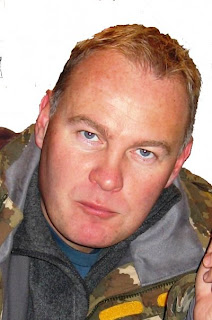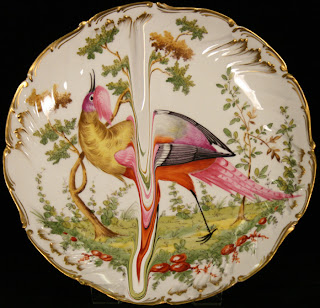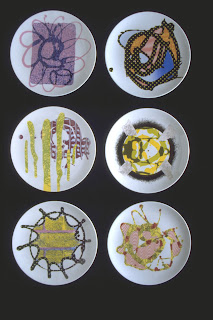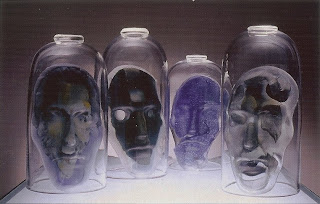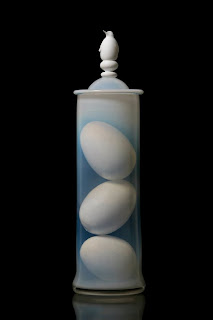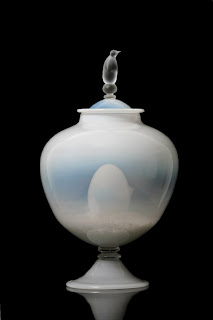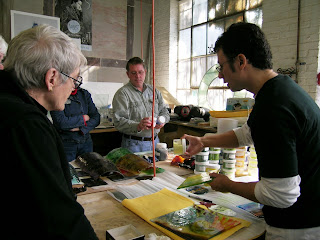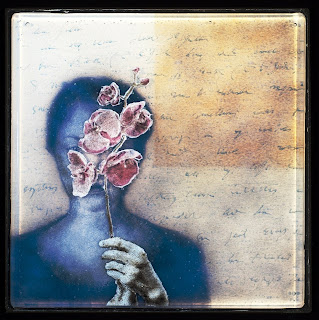>Kevin Petrie, professor of Glass and Ceramics at the UK’s University of Sunderland will be coming to the Glass Art Society’s (GAS) Conference at Toledo to talk with people interested in studies in glass at the University.
The
| The University of Sunderland Glass Facility |
The
From the
Students will be taught by international award-winning staff, who are all recognized professional artists, designers, curators and writers. You will also be offered real-world opportunities, including the chance to show your work in public exhibitions, undertake internships, work on live commissions, and enter competitions – all of which will help you to build your career.
We are a supportive creative community and encourage our students to become nationally, and internationally, networked during their time on the course. Our students have been selected for distinguished exhibitions such as the British Glass Biennale, Bombay Sapphire Glass Prize and the European Glass Context. Many of our graduates become independent artists with their own studios. Others are successful educators. A substantial number of our students are professionals who undertake doctorates to reflect on their work, advance creative practice and contribute to knowledge in the field of glass art.
Dinner with the Board of University of Sunderland and More Workshops!
>
Artist Jeffrey Sarmiento popped into the University of Sunderland’s Architectural Glass studio where our Fulbright workshop classes were being held with an invitation to show how he uses the National Glass Center’s waterjet to cut intricate and delicate glass elements for his artwork. Naturally, I was excited to see 1.) how the waterjet works and 2.) Jeffrey at work.
Jeffrey Sarmiento and Michael Janis
Jeffrey offered to make one of the component layers for the demo piece I was using to show how the sgraffito process can be achieved in glass, and he explained the process. We looked thru some of his images that were in the computer to save time, and selected one of his images of the nearby Tyne bridge that was part of his series “Invisible Cities“.
Jeffrey checks on the initialization of the process.
The pressurized water cuts through the glass and wood support panel.
The grit overflow tub.
The compressor unit located beyond the waterjet machinery.
The verticals of the waterjet cut Bullseye glass panel section are 3mm (less than 1/8″) thick.
Jeffrey pulls apart and assembles the positive and negative.
The connector nibs are pulled off each element.
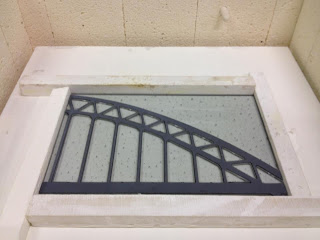
The panels section loaded and fused in the kiln.
The fired panel integrated into the demo piece.
Washington Glass Fulbright duo of Michael Janis & Tim Tate (plus Kay Janis as chaperone) soldiered on with dinner at the National Glass Centre, hosted by the University of Sunderland Board of Directors. The food at the dinner was a treat – my first Yorkshire Pudding. I was told that Yorkshire pudding and was told the story that the origins of the dish was to provide a cheap way to fill the diners – thus stretching a lesser amount of the more expensive ingredients as the Yorkshire pudding was traditionally served first. The dinner was nothing but elegant.
L-R Fulbright Scholar Tim Tate; Graeme Thompson, Dean of Faculty of Arts, Design and Media; Dr Kevin Petrie, Leader of Glass & Ceramics; (not shown in photo Shirley Atkinson, Deputy Vice-Chancellor; Peter Fidler CBE Vice Chancellor & Chief Executive and James Bustard, Director of the NGC).
The Yorkshire Pudding served.
L-R Cathy Barnes, Chair of the NGC Board; Kay Janis; Chris Jobe, Governor of the Board
Though not “lite” in the sense of calories, it was a delectable, light dessert that was served.
It was a lovely, fun evening that was filled with discussions on how we can create opportunities in both countries that would facilitate the exchange artists, ideas and ways we can strengthen the relationships we have developed.
We had time for one more workshop, held at Sunderland’s not-for-profit artist center, Creative Cohesion. This was to be a much more casual workshop, more a conversation – about the differences in the perceived US and the UK approach towards art and education, the changes that social media had on the art world, how artists can survive in tough economic times, the advantages of creating artist covenants.
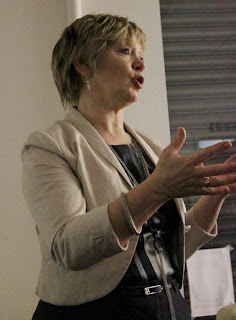
Anne Tye, the Creative Industries Development Manager at Sunderland City Council introduces Tim and Michael to a packed audience.


The talks were packed with artists from Sunderland, Newcastle – as far away as Edinburgh, Scotland.
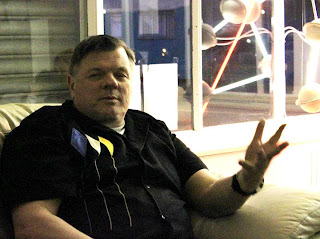
Tim Tate tells all.
The evening talk was the last of our scheduled Fulbright Scholar events. Our short project length had us fly out of town the next morning, heading back to Washington very early.
UK Artist profiles Part 3:
Andrew Livingston
Andrew Livingston works as an artist and is also Leader of CARCuos Ceramic Arts Research Center and MA Ceramics Program Leader at the University of Sunderland, The National Glass Center, Sunderland, UK.
Andrew’s work uses a range of media which acknowledges the interface between both traditional practice and new media. His continued exploration aims to challenge and expand contemporary locations in respect of the traditional positioning of ceramics. The integration of digital media and new technologies has become central to his artwork where new media is often positioned and juxtaposed with more traditional elements.
Andrew’s Parallax View series works in creating a fresh perspective on Tullie House‘s porcelain collection and explores preconceived notions of ceramics.
Surfeit 621 621 cast ceramic components, looped video, and drawings made from clay & graphite.
Britannia. ceramic and glass vitrine.
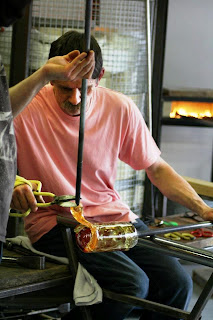
Roger Tye graduated from Manchester Poly in 1975 with a BA(Hons) in 3D Design – Glass and Metal. Roger to concentrate his work on sculptural and installation pieces that integrated glass and other media. Roger is the guiding force of the new not-for-profit artist studio – Creative Cohesion, located in Sunderland. Though Roger often works in creating beautiful traditional blown glass forms, he also works with slate and cast glass.

glass and slate
cast glass sheep, slate and steel
Click HERE to jump to first posting about the Sunderland trip.
Fulbright Scholars at University of Sunderland
>
Our Fulbright schedule began to fill the days.The first workshop we held at the University of Sunderland’s National Glass Center: “Affecting Sheet Glass – Bas-Relief Imagery in Glass” was filled. The technique of “dry plaster casing” was outlined, and firing schedules were converted from Fahrenheit to Celsius – along with converting all dimensions from imperial to metric. (Why did the US decide to not join the world in the 70’s when we were supposed to go all metricationed?)
Tim Betterton sets up the kilns for dry plaster casting.
After the firing, its like Christmas day as the students eagerly retrieve their kilnformed glass sculptures.
We were able to meet a number of incredibly talented artists that were associated with the University and their work was so strong that we will post some of the work and profiles about the artists in each of the next few blog updates:
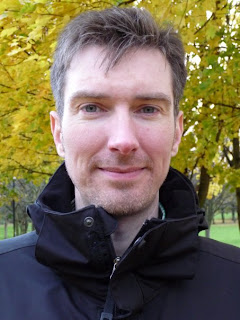
Dr Kevin Petrie leads the Glass and Ceramics department at the University of Sunderland. Kevin studied Illustration at the University of Westminster and Ceramics and Glass at the Royal College of Art. He holds a PhD in ceramics and print from University of the West of England, Bristol. Kevin’s first book ‘Glass and Print’ established the crossovers between Glassmaking and Printmaking. The book forms the cornerstone of a period of research that established the cross over between two largely separate strands of creative activity. His second book, ‘Ceramic Transfer Printing’ draws together the great potential of print for ceramics. Kevin has written many articles and reviews for journals such as Ceramic Review and presented his work on glass, ceramics and print in Canada, Thailand, Hong Kong, Denmark, Germany, USA, Australia, and China. He was recently awarded a National Teaching Fellowship for his contribution to glass and ceramics teaching, in particular this relates to postgraduate at MA, MPhil and Ph.D levels.
Dr Petrie’s work often refers to the long tradition of graphic ceramic surface decoration at the same time as reflecting contemporary life.
St Pauls Church, kilnformed glass
Cell of Himself, Kiln form glass with printed inclusions, blown glass
Besides his own work as an artist, Dr Petrie is an author, lecturer, exhibition curator, and he is an authority and specialist on contemporary glass and ceramics matters. He has lectured at the following institutions: The University of the West of England, Bristol, The University of Westminster, London, Norwich School of Art and Design, Bath Central St. Martins School of Art and Design, London, Rajabhat Institute Changmai, Thailand, Australia National University, Canberra, Australia, Monash University, Melbourne, Australia, Sydney College of the Arts, Australia, Anla Glas, Denmark, Hong Kong Baptist University – Academy of Visual Arts.
__________________________________________________________

If you are familiar with the first of the DC / Sunderland glass exhibition “Glass3” that was held in Georgetown in 2008, you might have seen James Maskrey‘s work. His work has really transformed into haunting and ethereal work. Social situations, overheard conversations, observed interactions and personal experiences hugely inspire Jim’s work. Tall stories, elaborate hoaxes and peculiar facts, usually from a bygone era, are then translated into glass, often resulting in flamboyant narratives, theatrical compositions or simple objects with a twist. The series below are from a series based on the polar expeditions by Edward Wilson to collect penguin eggs.
The Worst Journey in the World, blown and hot sculptured glass details, 2011. Photo by David Williams
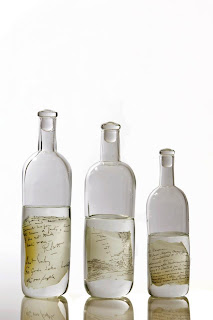

Last Entry,Winter Journey, andThe Barrier, 2011, Blown and solid formed hot glass with printed glass inclusions.
The works poetically and poignantly touches on themes of collecting and hubris. In the austral winter of 1911, Wilson led “The Winter Journey”, a doomed journey to the Emperor penguin’s breeding grounds at Cape Crozier to collect eggs for scientific study. The eggs were supposed to reveal the evolutionary links between dinosaurs and birds but their collection nearly killed the journey’s participants. Frozen and exhausted, they successfully collected three eggs and desperately exhausted they returned to Cape Evans, later describing this expedition “The Worst Journey in the World.”
James started working with glass in 1990. After graduating in 2000 with a Three Dimensional Design BA (Hons) degree in glass at The Surrey Institute of Art and Design he was appointed as Artist in Residence at the Surrey Institute. In 2001 James joined the Glass and Ceramics department at The University of Sunderland and graduated with an MA in Glass with distinction in 2004. Jim was recently named as one of the artists that will exhibit at the British Glass Biennale 2012.
Coming Next – London Affordable Art Fair & Imagery in Glass Class and featured Sunderland Artists: Jeff Sarmiento, Cate Watkinson and more!
Washington, DC Fulbright Scholars Connect with Ancestral Home of President George Washington
>As our time in the UK continued, Fellow Fulbright Scholar Tim Tate and I were invited to speak with students from St. Anthony’s – a technical specialist college in Sunderland.
Tim Tate & Michael Janis talk about the future of the arts to students at St Anthony’s in Sunderland, England.
After meeting with the students, Sunderland City Council’s Catherine Auld then took the DC crew on a quick jaunt to a couple of scenic spots that are around the city of Sunderland. First stop, the Town Hall and Indoor Market of Durham.
Tim Tate and Kay Janis at the Durham Town Hall.
Durham Town Hall and Market place were on the site since the Middle Ages. The current building dates from 1800’s.
Kay Janis seeks out notions from the indoor markets.
Nearby is the famed Durham Cathedral. The magnificent Romanesque structure dates from the 10th century, and boasts fine stained glass panels.
Durham Cathedral (and denim jeans artwork installation).
Catherine Auld, Kay Janis and Tim Tate at the Cathedral’s famed “Sanctuary Knocker”.

“Daily Bread” stained glass in Durham Cathedral by Mark Angus, 1984.
More importantly, the Cathedral, cloisters and grounds were used as some of the sets in the Harry Potter movie series.
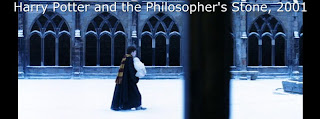
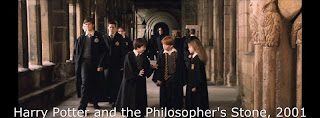
Professor Tate as Harry Potter and the Fulbright Scholar, 2012
The Saxon Origin of the Washington Family Name: This was, in fact, where the purely Saxon name of Washington derived. Among the first to bear it were the descendants of William de Hartburn near Stockton [-on-Tees], who came to live in the manor now known as Washington Old Hall as long before as 1183.
At that time, people in England and elsewhere had no surnames as we know them today, and were most often identified by the locations in which they lived. “Washington” was one of them. The name originally meant “the estate of the Hwaes family.’ “Hwaes” in its turn was the name of a Saxon chief, while “ynga” meant “family” and “ton” – a typically Saxon suffix – stood for “estate.” These three terms were linked and given a tinge of French since, like many prominent families in England, the new Washingtons sought to identify themselves with the French Plantagenet kings who succeeded the Normans and ruled England after 1154. The result was the original form of Washington – “de Wessyngton”.
Washington, DC Fulbright Scholars Tim Tate and Michael Janis pay homage to the Washington Old Hall in Durham County, UK.
Washington Old Hall was pulled down and rebuilt by the Bishop of Durham, who purchased the property from William de Wessyngton in 1613.Sadly, though, some three centuries later, it had become very dilapidated. The Hall was condemned as unfit for human habitation, and destined for demolition. It was fortunately saved from demolition by a committee specially formed to preserve it, and after thoroughgoing restoration work, the Hall was officially opened in 1955 by the then American ambassador, Winthrop W. Aldrich. Two years later, the Hall was taken over by the National Trust, an organization dedicated to preserving places of historical interest or natural beauty.
Garth Clark lecture on Ai Weiwei ceramics
The next morning, Garth Clark, noted art historian and critic – who the Washington Glass School has posted about his thoughts on the Death of Craft previously – gave a fascinating and provocative lecture about the work of Chinese bad-boy ceramic artist Ai Weiwei.
Click here to jump to first part of the Fulbright Journey blog posts.


